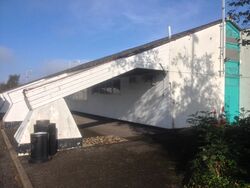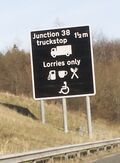Truckstop

A truckstop is a service area which is primarily aimed at lorry drivers, providing somewhere to park, eat and use toilets and showers.
As of 2010, they officially come in two forms: MT (motorway truckstop, a truckstop which is signposted from a motorway) and TRT (trunk road truckstop, a truckstop which is signposted from a non-motorway trunk road).
In practice there is an important third category: a place which provides the necessary facilities but (be it by choice or due to regulations) isn't signposted by the road. This website tends to only look at places which are officially recognised by the highway authorities.
The term "truckstop" is often conflated with lorry park. A lorry park is simply one facility that is provided, and it can form part of a truckstop, a service area or even stand on its own.
History
When the M1's motorway services were being designed, it became clear cars and lorries wanted different facilities. Lorry drivers would normally be given their own transport café with a menu aimed at people using the motorway every day, located close to the lorry park. Through the 1960s and 1970s the option of lorry-only services was investigated, but always dropped.
By the 1980s, facilities for lorry drivers were generally poor. Motorway service areas were tending to focus on families and businessmen, leaving HGVs feeling pushed out. Parking areas were often too small, meaning HGV drivers couldn't stop even if they wanted to, and the monitoring of driving hours was becoming stricter.
Motorway service areas hadn't been designed with overnight parking in mind, and in 1982 the main operators pleaded with the Department of Transport to find a way to reduce the pressure on their parking areas.
There was a market for a new generation of truckstops, which would be much larger than their predecessors. Their high construction costs and low profit margins meant there was only limited interest, and residents would usually oppose their development. Even so, there was some success: by the early 1990s a whole chain emerged called BP Truckstops, and there were three large, new sites signposted from the M6: Carnforth (part of the Truckhaven group), Lymm and J38 Truckstop.
BP sold their truckstops in 2002, and their successor, Nightowl, had long-running financial problems. The industry appeared to be in retreat.
Meanwhile highway authorities still appeared to be unsure how they should treat truckstops, with those named above being treated like motorway service areas, while others like J29 Truckstop only had signs referring to 'lorry parking'. This was clarified in 2008, with new regulations outlining what would be required before road signs would be provided.
With traffic levels continuing to rise, unofficial parking areas being closed for safety reasons, and new motorway service areas being slow to open, the lack of truckstops being an increasingly pressing problem. New regulations in 2010 permitted online motorway truckstops (truckstops which are directly accessible from the motorway and not via a junction). However, none have been built.
A major development was the opening of Rothwell Truckstop in 2019. As it was opened by motorway service area operator Welcome Break, who already operated a truckstop at South Mimms, it leaves open the opportunity of major motorway operators building more comprehensive truckstops.
Transport Cafés

A transport café (informally known as a truckers' café) is a restaurant reserved for HGV drivers only. They are different to truckstops in that they are there to provide food only.
Transport cafés existed long before motorways, providing food and toilet facilities to lorry drivers. A survey in 1960 found that there were over 1000 transport cafés in operation in the UK, but as motorways opened many of the old cafés would lose their trade.
When the first motorway service areas opened, transport cafés were an integral part of them. The reason was that lorry drivers and car drivers were generally different social classes, and it was felt that neither wanted to mix with the other. The transport café was usually cheaper, and provided a faster service.
The regulations stated that these motorway transport cafés must be close to the lorry park, with windows overlooking the vehicles, and were included either as separate buildings or part of the main building but with a separate entrance. Many of them were long, thin rooms. When closed, the café menu would need to be provided elsewhere at the services, with the same prices.
By the 1980s, the facilities for car drivers on motorways had become much less posh, as cars were becoming more accessible and the novelty of motorway travel had worn off. As a result, to save money, service areas developed a single café that would serve a simple menu to both car and lorry drivers. The separate motorway transport cafés quickly closed. Lorry drivers generally approved of the new arrangement, though they didn't like the steep prices.
At the same time, many of the traditional transport cafés on older A-roads were being purchased by Little Chef and Happy Eater, who banned all HGVs from their premises. This created an uneasy feeling that dedicated facilities for HGVs were no longer available. Some motorway service areas continued to rope off part of their restaurant for lorry drivers, though this practice ended in the 1990s.
Facilities and Requirements
As set out in the MSA Policy, MTs and TRTs must be no more than three miles from the motorway and not require drivers to pass through a settlement in order to reach them. They can't cater for other vehicles or else they surrender their status as a truckstop. Other than this their facilities are very similar to MSAs and TRSAs.
Truckstops may also double-up as an operating centre, subject to an assessment on the impact it would have, where HGVs can be parked up for the night and drivers return home in their regular vehicles.
Spacing and Locations
A motorway truckstop should not be more than 40 miles from the existing services, as if this isn't the case then getting a full service area open should be a higher priority. They weren't supposed to be less than 12 miles from the existing facilities, but this appears to be overlooked now.
There are few requirements for the location of truckstops on trunk roads.
Road Signs

TRTs are covered on the A-road Signs page as lorries only services.
For MTs, the signs were only introduced in 2008 as non-prescribed signs. They are similar to MSA signs but use white-on-black signs (like most signs aimed at HGV drivers) and substitute "services" for "truckstop", usually including the HGV symbol. Continuity signing should be provided using the existing available signs, and with black patches on other signs.
In the 2016 Traffic Signs Regulations and General Directions the signs were formally prescribed. Operator and brand logos are now permitted on the signs too.